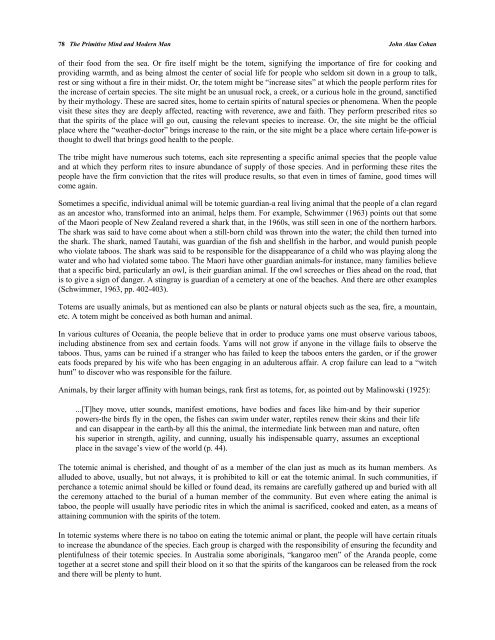chapter 1 - Bentham Science
chapter 1 - Bentham Science
chapter 1 - Bentham Science
You also want an ePaper? Increase the reach of your titles
YUMPU automatically turns print PDFs into web optimized ePapers that Google loves.
78 The Primitive Mind and Modern Man John Alan Cohan<br />
of their food from the sea. Or fire itself might be the totem, signifying the importance of fire for cooking and<br />
providing warmth, and as being almost the center of social life for people who seldom sit down in a group to talk,<br />
rest or sing without a fire in their midst. Or, the totem might be “increase sites” at which the people perform rites for<br />
the increase of certain species. The site might be an unusual rock, a creek, or a curious hole in the ground, sanctified<br />
by their mythology. These are sacred sites, home to certain spirits of natural species or phenomena. When the people<br />
visit these sites they are deeply affected, reacting with reverence, awe and faith. They perform prescribed rites so<br />
that the spirits of the place will go out, causing the relevant species to increase. Or, the site might be the official<br />
place where the “weather-doctor” brings increase to the rain, or the site might be a place where certain life-power is<br />
thought to dwell that brings good health to the people.<br />
The tribe might have numerous such totems, each site representing a specific animal species that the people value<br />
and at which they perform rites to insure abundance of supply of those species. And in performing these rites the<br />
people have the firm conviction that the rites will produce results, so that even in times of famine, good times will<br />
come again.<br />
Sometimes a specific, individual animal will be totemic guardian-a real living animal that the people of a clan regard<br />
as an ancestor who, transformed into an animal, helps them. For example, Schwimmer (1963) points out that some<br />
of the Maori people of New Zealand revered a shark that, in the 1960s, was still seen in one of the northern harbors.<br />
The shark was said to have come about when a still-born child was thrown into the water; the child then turned into<br />
the shark. The shark, named Tautahi, was guardian of the fish and shellfish in the harbor, and would punish people<br />
who violate taboos. The shark was said to be responsible for the disappearance of a child who was playing along the<br />
water and who had violated some taboo. The Maori have other guardian animals-for instance, many families believe<br />
that a specific bird, particularly an owl, is their guardian animal. If the owl screeches or flies ahead on the road, that<br />
is to give a sign of danger. A stingray is guardian of a cemetery at one of the beaches. And there are other examples<br />
(Schwimmer, 1963, pp. 402-403).<br />
Totems are usually animals, but as mentioned can also be plants or natural objects such as the sea, fire, a mountain,<br />
etc. A totem might be conceived as both human and animal.<br />
In various cultures of Oceania, the people believe that in order to produce yams one must observe various taboos,<br />
including abstinence from sex and certain foods. Yams will not grow if anyone in the village fails to observe the<br />
taboos. Thus, yams can be ruined if a stranger who has failed to keep the taboos enters the garden, or if the grower<br />
eats foods prepared by his wife who has been engaging in an adulterous affair. A crop failure can lead to a “witch<br />
hunt” to discover who was responsible for the failure.<br />
Animals, by their larger affinity with human beings, rank first as totems, for, as pointed out by Malinowski (1925):<br />
...[T]hey move, utter sounds, manifest emotions, have bodies and faces like him-and by their superior<br />
powers-the birds fly in the open, the fishes can swim under water, reptiles renew their skins and their life<br />
and can disappear in the earth-by all this the animal, the intermediate link between man and nature, often<br />
his superior in strength, agility, and cunning, usually his indispensable quarry, assumes an exceptional<br />
place in the savage’s view of the world (p. 44).<br />
The totemic animal is cherished, and thought of as a member of the clan just as much as its human members. As<br />
alluded to above, usually, but not always, it is prohibited to kill or eat the totemic animal. In such communities, if<br />
perchance a totemic animal should be killed or found dead, its remains are carefully gathered up and buried with all<br />
the ceremony attached to the burial of a human member of the community. But even where eating the animal is<br />
taboo, the people will usually have periodic rites in which the animal is sacrificed, cooked and eaten, as a means of<br />
attaining communion with the spirits of the totem.<br />
In totemic systems where there is no taboo on eating the totemic animal or plant, the people will have certain rituals<br />
to increase the abundance of the species. Each group is charged with the responsibility of ensuring the fecundity and<br />
plentifulness of their totemic species. In Australia some aboriginals, “kangaroo men” of the Aranda people, come<br />
together at a secret stone and spill their blood on it so that the spirits of the kangaroos can be released from the rock<br />
and there will be plenty to hunt.

















